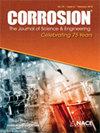评估钢筋混凝土结构用阳极寿命的阳极性能(GAP)试验的发展
IF 1.3
4区 材料科学
Q4 MATERIALS SCIENCE, MULTIDISCIPLINARY
引用次数: 0
摘要
NACE影响报告(2016)指出,近50%的钢筋混凝土结构在大约十年内经历大修。现有的补丁修复方法没有解决根本原因,可能不持久,导致重新修复和巨大的经济损失。镀锌阳极(GA)正在获得广泛接受,以实现几十年的免维护维修寿命。然而,一些特征不充分的GA过早地失败了(几个月内)。没有短期的测试方法来评估GA的寿命。因此,本工作的重点是开发一种短期测试方法(镀锌阳极性能(GAP)测试)来评估GA的寿命。为此,通过模拟CP保护的RC结构来设计GAP试样,如下所示:(i)嵌入垫层砂浆(即阳极)中的GA,(ii)镍铬网(即RC结构中模拟阴极钢筋的阴极),(iii)阳极和阴极的位置,(iv)施加电势差(0.5、1、5、10、20和30V)以加速GA的降解,和(v)模拟混凝土导电性的电解质。施加的电势>5V不能捕捉GA特性的差异。然而,0.5、1和5V的电位差可以显示GA在各种暴露条件下的真实行为。然后,提出了一种评估GA使用寿命的方法。通过评估包封砂浆的pH值和孔隙体积,研究了阳极过早失效的可能原因。GAP测试可以帮助实习工程师估计GA的使用寿命。本文章由计算机程序翻译,如有差异,请以英文原文为准。
Development of galvanic anode performance (GAP) test for assessing the longevity of galvanic anodes for reinforced concrete structures
NACE impact report (2016) states that nearly 50% of reinforced concrete (RC) structures experience major repair in about ten years. The existing approach of patch repair does not address the root cause and may not be durable – resulting in re-repair and huge economic loss. Galvanic anodes (GAs) are gaining widespread acceptance to achieve maintenance-free repair life for a few decades. However, a few GAs with inadequate characteristics are prematurely failing (within a few months). There are no short-term test methods to evaluate the longevity of GAs. Therefore, this work focuses on developing a short-term test method (Galvanic Anode Performance (GAP) test) to assess the longevity of GAs. For this, the GAP specimen was designed by simulating CP-protected RC structure as follows: (i) GA embedded in bedding mortar (i.e., anode), (ii) Nichrome mesh (i.e., cathode simulating rebars in RC structures), (iii) position of anode and cathode, (iv) application of potential difference (0.5, 1, 5, 10, 20, and 30 V) to accelerate the degradation of GAs, and (v) electrolyte to simulate conductivity of concrete. Applied potentials > 5 V could not capture the difference in characteristics of GAs. However, potential differences of 0.5, 1, and 5 V could show the true behavior of GAs in various exposure conditions. Then, an approach is proposed to evaluate the service life of GAs. Possible reasons for the premature failure of anodes were investigated by evaluating pH and pore volume of encapsulating mortar. The GAP test can help practicing engineers to estimate the longevity of GAs.
求助全文
通过发布文献求助,成功后即可免费获取论文全文。
去求助
来源期刊

Corrosion
MATERIALS SCIENCE, MULTIDISCIPLINARY-METALLURGY & METALLURGICAL ENGINEERING
CiteScore
2.80
自引率
12.50%
发文量
97
审稿时长
3 months
期刊介绍:
CORROSION is the premier research journal featuring peer-reviewed technical articles from the world’s top researchers and provides a permanent record of progress in the science and technology of corrosion prevention and control. The scope of the journal includes the latest developments in areas of corrosion metallurgy, mechanisms, predictors, cracking (sulfide stress, stress corrosion, hydrogen-induced), passivation, and CO2 corrosion.
70+ years and over 7,100 peer-reviewed articles with advances in corrosion science and engineering have been published in CORROSION. The journal publishes seven article types – original articles, invited critical reviews, technical notes, corrosion communications fast-tracked for rapid publication, special research topic issues, research letters of yearly annual conference student poster sessions, and scientific investigations of field corrosion processes. CORROSION, the Journal of Science and Engineering, serves as an important communication platform for academics, researchers, technical libraries, and universities.
Articles considered for CORROSION should have significant permanent value and should accomplish at least one of the following objectives:
• Contribute awareness of corrosion phenomena,
• Advance understanding of fundamental process, and/or
• Further the knowledge of techniques and practices used to reduce corrosion.
 求助内容:
求助内容: 应助结果提醒方式:
应助结果提醒方式:


